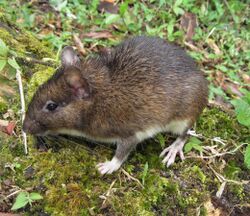Biology:Atlantic spiny rat
| Atlantic spiny-rat | |
|---|---|

| |
| Scientific classification | |
| Domain: | Eukaryota |
| Kingdom: | Animalia |
| Phylum: | Chordata |
| Class: | Mammalia |
| Order: | Rodentia |
| Family: | Echimyidae |
| Subfamily: | Euryzygomatomyinae |
| Genus: | Trinomys Thomas, 1921 |
| Type species | |
| Echimys albispinus | |
| Species | |
|
Trinomys albispinus | |
The Atlantic spiny rats are all found in the genus Trinomys. They are a group of South American spiny-rats in the family Echimyidae.[1][2]
Extant species of Trinomys
Based on Natureserve.[3]
| Trinomys albispinus | White-spined Atlantic spiny rat |
| Trinomys dimidiatus | Soft-spined Atlantic spiny rat |
| Trinomys eliasi | Elias's Atlantic spiny rat |
| Trinomys gratiosus | Gracile Atlantic spiny rat |
| Trinomys iheringi | Ihering's Atlantic spiny rat |
| Trinomys mirapitanga | Dark-caped Atlantic spiny rat |
| Trinomys moojeni | Moojen's Atlantic spiny rat |
| Trinomys myosuros | Mouse-tailed Atlantic spiny rat |
| Trinomys paratus | Spiked Atlantic spiny rat |
| Trinomys setosus | Hairy Atlantic spiny rat |
| Trinomys yonenagae | Yonenaga's Atlantic spiny rat |
The species of spiny rats in the genus Trinomys are apparently all Brazilian.[3] In particular many of them are endemic to the Atlantic Forest of southeastern Brazil. Not much is known for certain about their ranges however, which still are being investigated, with frequent extensions to the recorded distributions of several species in various ecological classes of forest and dry land. They do not however appear to occur at high altitudes, and several of their ranges appear to be parapatric.[4] Most species of Trinomys are terrestrial and ambulatory, though Trinomys yonenagae is unusual that it is semi-fossorial, living in colonial burrows, and exhibits incipient specializations for saltatorial locomotion.[5]
Phylogeny
Genus level
Trinomys is the sister genus to the fossorial genera Clyomys and Euryzygomatomys. In turn, these three genera — forming the clade of Euryzygomatomyinae — share phylogenetic affinities with a clade containing Carterodon and members of the family Capromyidae.
| Cladogram of the Euryzygomatomyinae with their relationship to Carterodon and Capromyidae. |
| The cladogram has been reconstructed from mitochondrial and nuclear DNA characters.[6][7][8][9][10][11] |
References
- ↑ Woods, C.A.; Kilpatrick, C.W. (2005). "Genus Trinomys". in Wilson, D.E.; Reeder, D.M. Mammal Species of the World: A Taxonomic and Geographic Reference (3rd ed.). Johns Hopkins University Press. ISBN 978-0-8018-8221-0. OCLC 62265494. http://www.departments.bucknell.edu/biology/resources/msw3/browse.asp?id=13400525.
- ↑ Lara, Marcia C.; Patton, James L. (December 2000). "Evolutionary diversification of spiny rats (genus Trinomys, Rodentia: Echimyidae) in the Atlantic Forest of Brazil". Zoological Journal of the Linnean Society 130 (4): 661–686. doi:10.1111/j.1096-3642.2000.tb02205.x.
- ↑ 3.0 3.1 InfoNatura: Animals and Ecosystems of Latin America [web application]. 2007. Version 5.0 . Arlington, Virginia (USA): NatureServe. Available: http://www.natureserve.org/infonatura.[|permanent dead link|dead link}}]
- ↑ Attias, Nina; Raíces, Daniel S. L.; Pessoa, Flávia S.; Albuquerque, Hermano; Jordão-Nogueira, Tássia; Modesto, Thiago C.; Bergallo, Helena de G. (June 2009). "Potential distribution and new records of Trinomys species (Rodentia: Echimyidae) in the state of Rio de Janeiro". Zoologia (Curitiba) 26 (2): 305–315. doi:10.1590/S1984-46702009000200013.
- ↑ Rocha, P.L.B.; Renous, S.; Abourachid, A.; Höfling, E. (June 2007). "Evolution toward asymmetrical gaits in Neotropical spiny rats (Rodentia: Echimyidae): evidences favoring adaptation". Canadian Journal of Zoology 85 (6): 709–717. doi:10.1139/Z07-049.
- ↑ Galewski, Thomas; Mauffrey, Jean-François; Leite, Yuri L. R.; Patton, James L.; Douzery, Emmanuel J. P. (2005). "Ecomorphological diversification among South American spiny rats (Rodentia; Echimyidae): a phylogenetic and chronological approach". Molecular Phylogenetics and Evolution 34 (3): 601–615. doi:10.1016/j.ympev.2004.11.015. PMID 15683932.
- ↑ Upham, Nathan S.; Patterson, Bruce D. (2012). "Diversification and biogeography of the Neotropical caviomorph lineage Octodontoidea (Rodentia: Hystricognathi)". Molecular Phylogenetics and Evolution 63 (2): 417–429. doi:10.1016/j.ympev.2012.01.020. PMID 22327013.
- ↑ Fabre, Pierre-Henri; Galewski, Thomas; Tilak, Marie-ka; Douzery, Emmanuel J. P. (2013-03-01). "Diversification of South American spiny rats (Echimyidae): a multigene phylogenetic approach". Zoologica Scripta 42 (2): 117–134. doi:10.1111/j.1463-6409.2012.00572.x.
- ↑ Fabre, Pierre-Henri; Vilstrup, Julia T.; Raghavan, Maanasa; Der Sarkissian, Clio; Willerslev, Eske; Douzery, Emmanuel J. P.; Orlando, Ludovic (2014-07-01). "Rodents of the Caribbean: origin and diversification of hutias unravelled by next-generation museomics". Biology Letters 10 (7): 20140266. doi:10.1098/rsbl.2014.0266. PMID 25115033.
- ↑ Upham, Nathan S.; Patterson, Bruce D. (2015). "Evolution of Caviomorph rodents: a complete phylogeny and timetree for living genera". Biology of caviomorph rodents: diversity and evolution. Buenos Aires: SAREM Series A, Mammalogical Research — Sociedad Argentina para el Estudio de los Mamíferos. pp. 63–120.
- ↑ Fabre, Pierre-Henri; Upham, Nathan S.; Emmons, Louise H.; Justy, Fabienne; Leite, Yuri L. R.; Loss, Ana Carolina; Orlando, Ludovic; Tilak, Marie-Ka et al. (25 December 2016). "Mitogenomic phylogeny, diversification, and biogeography of South American spiny rats". Molecular Biology and Evolution 34 (3): 613–633. doi:10.1093/molbev/msw261. PMID 28025278.
Wikidata ☰ Q846036 entry
 |

